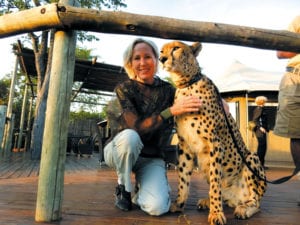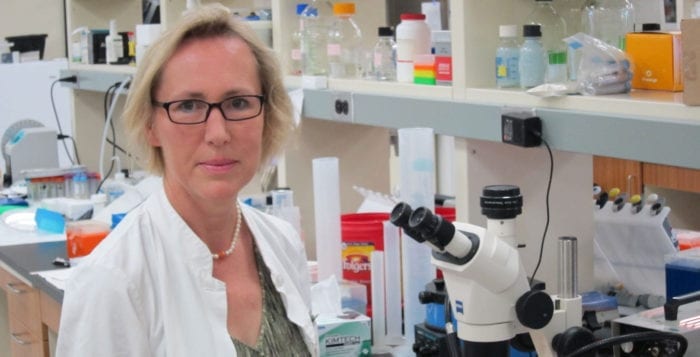SBU’s Moll finds gene for airway cleaners
Some day, people may be able to breathe easier because of a cancer researcher.
No, Ute Moll doesn’t work on respiration; and, no, she doesn’t study the lungs. What Moll, research scientist Alice Nemajerova and several other collaborators did recently, however, was explain the role of an important gene, called p73, in the formation of multiciliated cells that remove pollutants like dust from the lungs.
Initially, scientists had studied a knockout mouse, which lacked the p73 gene, to see if the loss of this gene would cause mice to develop cancers, the way they did for p73’s well-studied cousin p53. Researchers were surprised that those mice without p73 didn’t get cancer, but found other problems in the development of their brains, which included abnormalities in the hippocampus.
While each of these mice had a respiratory problem, researchers originally suspected the breathing difficulties came from an immune response, said Moll, the vice chair for experimental pathology and professor of pathology at Stony Brook University.
A board-certified anatomical and clinical pathologist who does autopsies and trains residents at Stony Brook, Moll took a closer look and saw an important difference between these mice and the so-called wild type, which has an intact p73 gene.

“Microscopic examinations of many types clearly showed that the multiciliated cells in the airways were severely defective,” she explained. “Instead of a lawn of dense long broom-like motile cilia on their cell surface which created a strong directional fluid flow across the windpipe surface, the [knockout] cells had far fewer cilia, and the few cilia present were mostly short stumps that lost 100 percent of their clearance function.”
This finding, which was published in the journal Genes & Development, could have implications for lung diseases such as chronic obstructive pulmonary disease, or COPD, which affects more than 330 million people around the world and is the third leading cause of death.
The discovery provides “the long-awaited explanation for the diverse phenotypes of the p73 knockout mice,” wrote Elsa Flores, a professor of molecular oncology at the UT MD Anderson Cancer Center, in a commentary of the work.
In an email, Flores said Moll is a “wonderful collaborator and colleague” whose “meticulous” work is “held in high regard.”
Carol Prives, Da Costa professor in biological sciences at Columbia University, suggested this was a “very significant finding.”
Moll and her scientific team went beyond showing that the loss of the p73 gene caused the defective or missing cilia. They took stem cells from the trachea, which can grow on a culture dish into a range of other cells. With the proper nutrients and signals, these stem cells can grow back into a fully differentiated respiratory epithelium.
The organotypic culture had the same defects as the knockout mice. The scientists then used a lentivirus to insert a copy of the functioning p73 gene. The cells in the culture developed a complete set of long, motile cilia.
“It’s a complete rescue experiment,” Moll said. “This closes the circle of proof that” p73 is responsible for the development of these structures that clean the lungs.
In addition to the lungs, mammals also develop these cilia in two other areas, in the brain and in the fallopian tubes.
There could be a range of p73 deficiencies and some of these could be indicative of vulnerability or susceptibility to lung-related problems that are connected to incomplete cilia. This could be particularly valuable to know in more polluted environments, where the concentration of dust or pollutants is high.
Moll plans to “find tissue banks from COPD patients” in which she might identify candidate alleles, or genes, that have a partial loss of function that would contribute to the reduction in the cilia cells.
While Moll will continue to work on respiration and p73 in mice, she described her broader research goals as “gene-centric,” in which she studies the entire p53 family, which includes p53, p63 and p73.
Colleagues suggested that she has made important and unexpected discoveries with p53.
“She was among the first to show that in some pathological states, p53 is sequestered in the cytoplasm rather than in the nucleus,” Prives, who has known Moll for 25 years, explained in an email. “This led to her original and very unexpected discovery that p53 associates with mitochondria and plays a direct role in mitochondrial cell death. She was very courageous in that regard since the common view was that p53 works only in the nucleus.”
Moll was raised in Germany and earned her undergraduate and medical degrees in Ulm, the same town where Albert Einstein grew up. She lives in Setauket with her husband, Martin Rocek, a professor of theoretical physics at SBU. The couple has two sons, 26-year-old Thomas, who is involved in reforestation in Peru, and 29-year-old Julian, a documentary filmmaker focusing on environmental themes.
Moll is also focused on the environment.“If humankind doesn’t wake up soon, we are going to saw off the branch we’re sitting on,” she warns. One of Moll’s pet peeves is car idling. She walks up to the windows of people sitting in idling cars and asks if they could turn off the engine.
As for her work with p73, she feels as if she is “just at the beginning. This is a rich field.”







